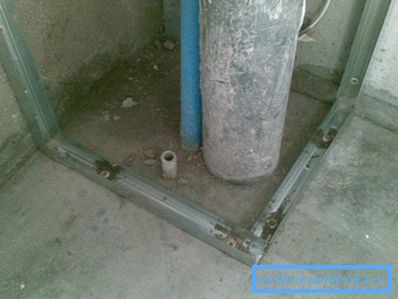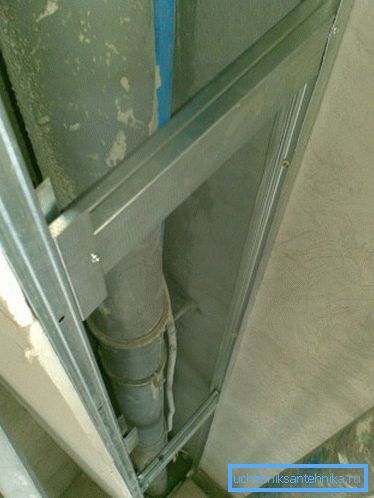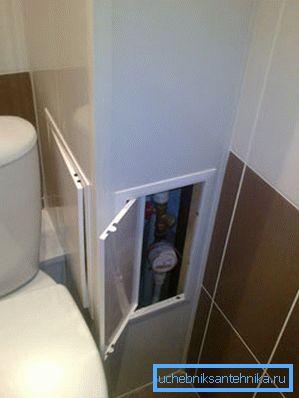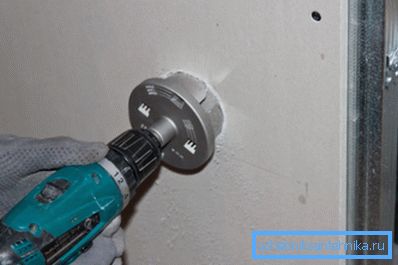How to close the pipe drywall - tidy interior
After the installation of sewage systems, plumbing and heating, the bulk of the work can be considered as done. It remains only to solve the question of what to do with the pipes, it is unlikely that they will decorate the interior of the room. The solution to this problem may be their disguise behind a plasterboard partition.

What is the optimal material for the partition?
Already after the laying of the pipeline, people wonder how to close the pipes in the kitchen with drywall (and in any other room). To do this, you just need to assemble the frame and sheathe it with drywall or any other material.
You can use not only drywall, but also materials such as wood, plywood, thin metal sheets for covering the box frame. However, it is drywall that is most often used for this.

The popularity of this material is due to the following factors:
- it is much lighter than wood or metal;
- even when heated, it does not emit harmful substances into the atmosphere, this is important when the heating pipes are closed;
- It is also important that after the installation of the partition there are no restrictions on its finishing. It can be painted, or even tiled with tiles;
- In addition, the price of drywall is low, and the partition is hardly needed more than 1-2 sheets.
Partitioning technology
The whole process can be divided into 3 stages:
- layout;
- frame installation;
- sheathing frame.
After this, it will only be necessary to finish the partition so that it does not stand out from the general style of the room.

Layout
At the planning stage, the contour of the future partition should be marked on the floor and ceiling. Its walls must be strictly vertical, so when transferring the contour from the floor to the ceiling, you will need a building level.
The marking instructions are as follows:
- the contour of the future partition is drawn on the floor at right angles to the walls of the room. It is important to maintain the distance from the wall of the partition to the pipe itself. It is desirable that it is equal to at least 5 - 7 cm;

Note! When the heating pipes are closed, this distance can be increased. It is undesirable that the partition wall is very hot, this can adversely affect the quality of the finish.
- after the contour on the floor is ready, the uprights are attached to the corners (rack profile), with the help of the level it is adjusted to the vertical position and the position of the angle of the partition is marked on the ceiling. The operation is repeated several times;
Frame Mounting
When you need to close the pipes in the toilet with drywall or in another room with a high level of moisture for the frame, it is better to use galvanized metal profiles. It will take 2 types of profiles: UD - attached to the floor and ceiling, as well as a CD-profile - will serve as racks and horizontal partitions.

Although, for the frame, you can use the usual wooden planks, but this design will be more cumbersome. Also, using wood in the kitchen or bathroom is not the best idea.
To the floor and among themselves the metal profiles are connected with small screws.
The assembly of the frame must be maintained in the following sequence:
- first guides are attached to the floor and ceiling;
- then in the corners of the box, rack profiles are installed, their verticality is additionally controlled. These same profiles must be installed against the wall;

- in order to ensure the rigidity of the structure, crossbars of the same rack profile are fixed between the posts; a step between them can be taken about 60 cm.

Frame casing
Sheets are attached to metal profiles with self-tapping screws. For cutting sheets it is convenient to use a knife. The sheet along the pre-marked line is cut by about 2/3 of the depth, then put backside on the edge of the table and breaks sharply.
After that, it remains only to cut a thin layer of cardboard with a knife.
When all the work is done by hand, be sure to consider the purpose of the room. So, for the living room, drywall is suitable, but for the bathroom, kitchen and bathroom it is recommended to use moisture resistant drywall (it differs from the usual greenish color).

The inside of the box must be ventilated. For this, a small hole is left in the upper part of the frame (at least 5 cm in diameter).
In addition, at any time you may need access to the pipeline, for example, in the case of the flow of joints. For the audit in the box, it is desirable to provide a door opposite the taps, fittings.
After finishing the partition, the door will be almost invisible.

Note! Inside the box should not get moisture out of the room, so the joint of drywall and the floor, as well as the walls filled with foam. In the bathroom joint can be filled with sealant.
The space between the sheets and the wall can be filled with heat and sound insulating material, for example, mineral wool. Due to this, the noise in the pipes will be absolutely inaudible.

How to hide the heating pipes?
When deciding how to close the heating pipe with drywall in the room, in general, the procedure is maintained. Differences in technology associated with high temperature pipes with coolant.
As a rule, the heating radiator is located under the window, approximately in the middle of the wall. Therefore, in addition to the vertical pipeline, there is also a significant length of horizontal pipe in the room.

When masking heating pipes plasterboard partition is better to bring to the ceiling in the area from the riser to the radiator. Loss of free space will be almost imperceptible, but the partition will not be allocated.
In addition, more intensive ventilation should be provided. Large holes in drywall will be too conspicuous, so you can drill a lot of small holes along the pipeline.

Summarizing
Thanks to simple actions, the pipeline will no longer disfigure the interior of the rooms. At the same time, the installation of the partition is carried out literally in a matter of hours, and all the work can be done by oneself without attracting specialists (see also the article How and for what purpose drainage pipes are used at the site).
In the video in this article, the issue of pipe masking behind a false wall of plasterboard is considered in detail.